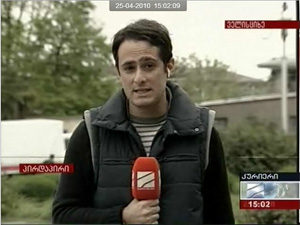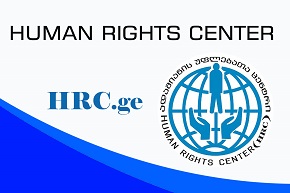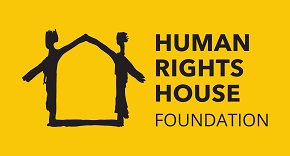Natalia Sarkisashvili, Gela Mtivlishvili
 The main topic of the news programs of the national TV-Companies from April 23 till April 26 was the emergency situation in the village of Velistsikhe in Gurjaani district (Kakheti). Ministers of internal affairs, regional development, agriculture, environment, Kakheti regional governor, deputy governor and Gurjaani district governor were interviewed in the morning, afternoon and evening releases of Kurieri, Moambe and Kronika.
The main topic of the news programs of the national TV-Companies from April 23 till April 26 was the emergency situation in the village of Velistsikhe in Gurjaani district (Kakheti). Ministers of internal affairs, regional development, agriculture, environment, Kakheti regional governor, deputy governor and Gurjaani district governor were interviewed in the morning, afternoon and evening releases of Kurieri, Moambe and Kronika.
“Warning: Leave Your Homes Soon”
The evacuation started at 9:00 pm on April 22 in Velistsikhe. The policemen were requesting the people from patrol cars to leave their houses promptly. For those who did not have cars to leave the village, the mini-buses were waiting in the village center.
Guliko Mamulashvili, resident of the Velistsikhe village: “Nobody told us why we had to leave our homes. They were only shouting and ordering us to leave the Khevisubani (ravine) area immediately. Several minutes later ambulances and patrol police cars mixed with each other. People went out in the street. Nobody knew anything. People were running in different directions. We could not even think of taking our car from the garage; we grabbed our children and ran away. There was terrible panic in the village. We asked patrol policemen what was going on but nobody told us anything. They just told us to go to the village center. Several minutes later, there was no place in front of the Culture House. Besides the residents of the Khevisubani settlement, people from other districts also went out in the street. Kakheti regional governor Giorgi Ghviniashvili and Gurjaani district governor Giorgi Chiviashvili were in the village center. They said that the Cheremi Lake had flooded and the water could flow over the jetty any minute and destroy everything close to the river. Who had relatives in the neighboring villages were taken there by mini-buses; the rest were sheltered in the Culture House.”
There was such a serious panic in the village that it caused traffic-jam on Telavi-Tbilisi motor-way. The people were fleeing from Velistsikhe. The regional governor ordered the petrol-stations in the area to work 24 hours.
One hour after the evacuation, the minister of environment and natural resources Goga Khachidze arrived in the village together with the film-crew of the press-center of the ministry. “We do not have the right to leave even one citizen in a dangerous situation. So, we are taking emergency measures. At the moment we are working. There is a risk and we do not have the right to leave even a single person under this risk,” said Khachidze in his interview with the journalists of the Public Broadcasting, Rustavi 2 and Imedi-TV.
Several minutes later, the village center and surrounding area was overcrowded by the cars of the rescue teams of the MIA, Kakheti region police department and district police stations, patrol police cars and ambulances. Except Gurjaani the brigades of the first medical aid from Telavi and Kvareli were mobilized in the area; the doctors could not manage to assist everybody. Many people fell down in the streets because of fear and running and doctors tried to recover them. About one thousand people gathered in the village center and requested the officials to explain why they were asked to leave their houses. “Cheremi Lake has flooded and it can overflow at any time. You were evacuated for that reason. You should spend this night at your relatives’. We will assist you in everything,” said the deputy regional governor Giorgi Sibashvili. “Those who have cars can leave the village without our help. But we will help the rest,” the district governor Giorgi Chiviashvili told the Velistsikhe residents.
Deputy regional governor Girogi Sibashvili, chairman of the Gurjaani municipality board Zakaria Iaganashvili and other officials categorically denied the spread information about the death of a woman. According to the official information, two people – Zakaria Varazashvili and Tariel Gabelaia - were taken to the hospital because of heart problems. Zina Abelashvili died before the ambulance came. The family members said the woman had heart-attack. “When they were warning us to leave the houses, she got scared. We could not understand what was going on. She was very worried. Suddenly she felt bad and before doctors came she died,” said the son of the dead woman Givi Abelashvili. After the death of a person was confirmed, deputy regional governor reported to the journalist that the woman had health problems; she had colitis and the panic had nothing to do with her death.”
At 11:50 pm the head of the administration at the MIA Shota Khizanishvili arrived in Velistsikhe, minister of internal affairs Vano Merabishvili, minister of justice Zurab Adeishvili and minister of regional development and infrastructure Davit Tkeshelashvili followed him ten minutes later. The ministers, including Khachidze together with the regional governor gathered in the office of the commissary of the territorial entity and held a closed meeting. After the meeting, Merabishvili, Adeishvili and Tkeshelashvili left the village without making any comment.
It was reported that the emergency HQ was set-up with the leadership of the Kakheti regional governor Giorgi Ghviniashvili.
One hour after the minister of internal affairs left the village, a special unit was deployed in Velistsikhe. On that night, most part of the residents spent night in the street. According to the HQ, on April 22 about 600 families were evacuated from Velistsikhe.
April 23
Morning news-programs showed the evacuation process of the people and comments of the environmental minister. Despite the emergency situation, part of the evacuated population returned to their homes. On April 23, deputy regional governor made statement about the reasons of flooding. He said it was caused by the deconstruction of the channel which released extra-water from the lake. “If the water floods, the natural disaster will destroy the Khevisubani district and it will cause huge casualty,” said Sibashvili. He added, despite the heavy rain, on April 23, they started working to reduce the water level in the lake; the process was led by the environmental minister and regional governor on the place.
At 11:00 am the cars of live-transmitting of Rustavi 2 and other TV-Companies arrived in Velistsikhe and started to show the ongoing events on-live. At 7:30 pm the population was evacuated from the village again. The deputy head of the department for emergency situations at the MIA Pridon Sadunishvili said about 1 000 families live in the risk zone – Khevisubani district. The population was under risk for what they were warned to leave the ravine of the River Cheremi immediately. The news-programs of the three national TV-Companies live-broadcasted the events from the village all day long. They underscored that the governmental officials were at the place of the natural disaster and did their best to improve the situation. The prime-minister Nika Gilauri also gave interview to the journalists; he said that the governmental officials are in Velistsikhe and they control the situation in the place.
In the morning of April 24, part of the evacuated population returned to their homes. In the evening they were not evacuated. On April 25, minister Vano Merabishvili arrived in the village again and said that the channel for the release of the extra-water was damaged in the lake and they exploded it. “By these and other activities you know that we have installed so-called “Siponi funnel”, consequently, the level of the water lowered in the lake and people can be calmer,” said the minister.
“Thank You for Having Rescued Us”
On April 26, the national TV-Companies broadcasted the interviews of the Velistsikhe residents who heartily thanked the central and local government for their assistance.
“The entire village residents spent last night at their homes. We are very grateful to the government, the ministers and particularly to our regional governor’s administration who supported us so much. Everything was organized and today the situation is really stable,” said the resident of the village Keti Gelitashvili, activist of the Gurjaani district office of the National Movement.
Kakheti regional governor returned from Cheremi Lake at about 4:00 pm but refused to make comments to journalists. At 6:00 pm he gave a live-interview to the Kurieri (news-program of Rustavi 2) and announced that the emergency situation was canceled in Velistsikhe. In that evening, Gurjaani district governor Giorgi Chiviashvili wrote a resignation letter; he is candidate of the intermediate parliamentary elections of May 30, 2010 from the National Movement in Gurjaani district.
On April 27, the members of the parliamentary majority made comments about the situation in Velistsikhe. “As a result of the hard work of rescue teams, local population is out of risk. It was really a good job. The members of the rescue teams were accused of being the activists of the ruling party. Now, everybody should know why we established the rescue teams and what the criteria were to select the members,” said the secretary general of the National Movement Zurab Melikishvili.
In the evening of the same day, President Mikheil Saakashvili responded to the events in Velistsikhe from the USA. “These days there was serious threat of flooding the village Velistsikhe by the water from the reservoir. I have not slept the last three nights. I know that the local officials and ministers are working hard day and night. We were just in time to rescue the people. The water is already pumped out from the lake and I think somebody could have satisfied his/her ambition if not the coordination of the governmental officials; the situation of the villagers could have been very urgent in this case. Our country has many other challenges but consolidation of one team is very important,” said the president.
History of Cheremi Reservoir
The reservoir is in the river Veti. In the past there was a natural lake there and the reservoir and barrage were built there early in 1980s for the irrigation of the surrounding area. The reservoir was to be filled in by the water of the River Veti mechanically. It is built on the 10 hectares of land and its depth was 28 meters. The reservoir has stopped its irrigation function for the last years. In 2006, the Ministry of Economic Development sold the 50 % of it and the Kachreti Product Ltd purchased it.
Representatives of the Kakheti regional administration clarified that the director of the company informed them about the threat. “Based on his letter, the specialists studied the situation on the reservoir and made conclusions. The emergency situation was announced based on the conclusion,” said Giorgi Sibashvili.
Specialists examined the reservoir on April 22. “The channel is in poor conditions. Because of heavy sediment, the level of water in the lake has raised and reached the channel from where extra water is overflowing. The water destroyed the channel and created a deep ravine with water-fall. Currently, the water-fall is flowing under the bridge over the road which has washed the soil of the piers and can be pulled down. It is noteworthy, that the height of the water-fall is 3-4 meters and is 10 meters away from the lake-bank. Periodically, the plates and priming is pulling down by the water-fall and it reaches the lake-bank. Besides that, the pipe of 500 mm is not working now and the water is not releasing from the lake. Bearing the all above in the mind, there is real threat that the lake can destroy the jetty and overwhelm the villages Velistsikhe and Mukuzani; it will result in huge casualty,” stated the protocol signed by the employees of the department for emergency situations and institute for water-management as well as entrepreneur Baramidze.
Director of the institute for water-management, doctor of technical science Givi Gavardashvili clarified that it was necessary to lower the level of the water in the lake by any means, among them by using simpons; however, the speed of the lowering the water-level should not have exceeded 20 centimeters per day; the process was to be permanently monitored. In parallel to it, the functioning of the water-releasing pipe was to be restored.
Despite many attempts, we could not arrive at the Cheremi reservoir. During the emergency situation the patrol police did not allow us to go there; they had blocked the road. The cameraman of the press-center of the Ministry of Environment was allowed to record the ongoing activities on the reservoir. It was later shown by the TV-Companies that the people had arrived at the Cheremi Reservoir by cars however, on the phone, the residents of Cheremi village told us that people could go there only by trucks. “After rains, there was such a mud on the road that after the reconstruction activities finished and the workers left the area, the road was dug in various places for what cars cannot drive,” the residents of the village Cheremi told us. They said they also saw a pipe for the release of extra water which was damaged but the water was flowing from the lake without it. “Nobody pays attention to the reservoir for the last few years; the pipe was not damaged now? It has been filled up for a long time and did not let the water go,” said the villagers.
“The Village Was Not In Danger”
A specialist said in his conversation with the Caucasian Environmental NGO Network that the situation was not dangerous in the Cheremi reservoir. He requested to keep his name anonymous.
“This reservoir has been working for 28 years already and nobody has paid attention to it for the last 20 years. Similar constructions shall be examined at least once a year. Consequently, there should be a corresponding agency. In the past, the Ministry of Melioration did the job; later the agencies of melioration exploitation examined the reservoirs and they had offices in every district.
-How real was the danger?
-There is 22 kilometers distance between the reservoir and the village. According to the preliminary data, if the barrage had pulled down, the lower part of Mukuzani village and Khevisubani in Velistsikhe should have faced some problems. The water could destroy the sheds located on the edge of the ravine. The locals said the river was attacking them but in fact, they attack the river. However, when we arrived at the place, it became clear that there was no danger in the village.
The barrage is made of stones. If the water had washed it away intensively in dangerous direction (what did not happen), there was some threat (2-3% possibility) that the barrage could not hold the water. However, the reservoir would not have emptied from water anyway. Only 6 meters of water could have released from the lake and gradually. If the situation had got complicated, the process could have caused half-meter falls and the water could have lowered by half-meters.
Today the depth of the barrage is less than it is indicated in the project and is 18-19 meters. The rest space was already filled in. the reservoir could not have emptied completely except the possibility of 0, 0001 %.
Director of the Saktskalproekti (Georgian water projecting company) Geidar Palavandishvili also confirmed the information. “The accident, which could release whole water from the reservoir and destroy the residential area, could not have happened. The information provided by the anonymous specialist is correct. Our specialists also worked at the reservoir and I know that the barrage is in good conditions. Only the channel for the release of extra water was damaged. In general, the water shall be released from the barrage. But much water never entered the reservoir. Cheremi ravine has very small affluent which supplies the lake with water. The water started to fall from the damaged place but the situation was not dangerous for people.”
News
December 13, 2023
Ethnic minorities outside the peace dialogue
November 6, 2023
‘Peace’ agenda of political parties
Popular
Articles
February 13, 2024



